We look back at the highs, lows and other key events of the past 12 months
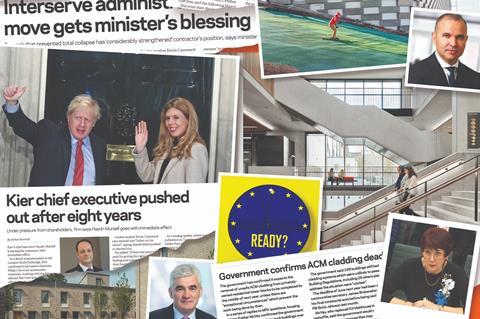
Brexit and the economy
Few would have thought at the beginning of 2019 that the year would end with a thumping majority for the Conservatives in a second general election in two years.
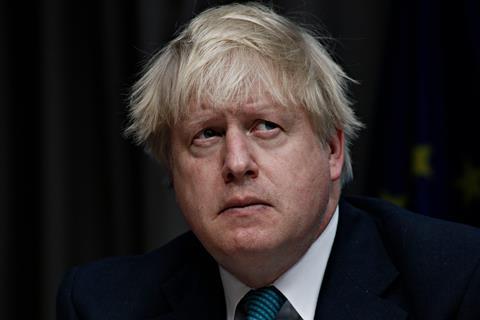
Bogged down by Brexit, and with Theresa May just about hanging onto the keys of Number 10, everything was up for grabs as the year began. Much unease resulted from the country finding itself mired in political deadlock, centred – unsurprisingly – around Brexit.
Political inertia played a part in knocking the construction sector’s confidence for six; numerous surveys reported construction output suffering under the weight of uncertainty, with projects being shelved and investment plans reined in. Stalemate over the country’s efforts to leave the EU and a lack of visibility over the direction of the domestic economy prompted many clients to hit the pause button, with the inevitable knock-on effect for construction firms.
Construction output:
>> February - Brexit blamed as output falls to lowest points in close to a year
>> April - Under 30s upbeat about construction, –«ø’¥´√Ω survey finds
>> May - Brexit stalemate and rising costs hit construction in first quarter
>> June - Output shrinks in may on back of commercial and civils woe
>> July - Output falls at the steepest rate for more than a decade
>> August - Commercial output hit by Brexit fears
>> October - Construction activity falls at second-fastest rate since April 2009
The Construction Leadership Council convened an emergency Brexit summit in January as more than 100 industry leaders, including the bosses of Mace, Skanska, Vinci and Derwent London, gathered to develop sector contingency plans for the possibility of a no-deal exit.

Fast forward 12 months and that inertia is now dead and comprehensively buried. Boris Johnson, elected Conservative leader and prime minister in the summer, took a gamble to hold the second election in as many years on a ticket to “Get Brexit Done” and it proved to be a decision that paid off in spades. His 80-seat majority puts an end to the deadlock and means the UK will leave the EU at the end of next month. There will then follow the job of negotiating the terms of a trade agreement with Brussels, something the prime minister has promised will be achieved by the end of 2020.
Contractor and housebuilder share prices rocketed in the aftermath of the election as a majority government restored confidence in the market’s ability to push ahead with project starts next year.
The construction industry will want as soft a Brexit as possible, something that Johnson may now be able to deliver. It will, however, remain wary of a future immigration policy whereby its EU workforce is not deemed skilled enough to work in the UK, particularly at a time when large infrastructure projects are given the green light.
>> Read: Industry calls for post-Brexit immigration regime overhaul
The new government’s legislative programme was due to be set out in the Queen’s speech yesterday, with the budget expected at the end of February or the start of March.

The sector will also want clarity on matters closer to home. The new government will have to confront the housing crisis. The Tories have pledged to build a million homes during the next parliament – at 200,000 homes a year, this is significantly below its previous goal of 300,000 a year by the mid-2020s. Decisions will also need to be made around big infrastructure projects over the next five years, including HS2 and the expansion of Heathrow airport.
Housing:
>> February - Housebuilders warn government’s 300k homes target is unachieveable
>> June - Government ‘lacks clear plan’ for delivering 300,000 homes a year, say MPs
>> July - Use MMC or miss 300,000 homes-a-year target, MPs warn government
>> November - Social housing numbers fall
Johnson has promised to build 40 new hospitals, which should generate plenty of work across the country, assuming his pledge wasn’t simply campaign rhetoric. More broadly, the state of the domestic economy will remain a concern, and the construction sector will be hoping the government can get it fired up again as soon as possible.
>> Read: General election 2019: What are the Conservatives promising construction?
Movers
With uncertainty rife, it is perhaps no surprise that there has been movement at the top of some of construction’s biggest businesses.
The start of the year saw Kier chief executive Haydn Mursell leave the company after five years. He was replaced by ex-Wates boss Andrew Davies in a move that sparked several other top-level departures.

Chief operating officer Claudio Veritiero left last month with immediate effect, having been in the role for just over a year, while finance director Bev Dew departed in September after more than four years in the job.
Multiplex also saw its chief executive, Ashley Muldoon, leave last month. He had been with the business for 22 years.
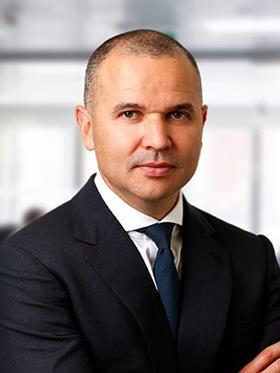
A day after Muldoon’s departure was announced, Interserve revealed that Debbie White, its chief executive, would leave at the end of 2019 after two years in the job – a period she described as “the most demanding of [her] professional career”. Chief financial officer Mark Whiteling left in February, after just 18 months with the firm.
Director Dougie Sutherland also left Interserve in February, having spent 12 years at the company, while Matt Bray, director and founder of its fit-out business Paragon, also left.
Meanwhile, ISG construction boss Gordon Kew left the company in October after just nine months in post and barely more than a year after leaving Interserve.
In April Lendlease chief executive Dan Labbad revealed that he would be leaving to head up Crown Estates next year. His departure led to internal promotions including the naming of Neil Martin as chief executive of its Europe arm, Simon Gorski as the boss for construction in Europe and David Cadiot as the contractor’s regional executive general manager for the UK.
Lendlease:
>> April - Lendlease boss taking £1m pay cut in Crown Estate move
>> August - Lendlease rejigs residential business
>> September - Lendlease names new Europe chief exec
>> November - Lendlease names new UK regional boss
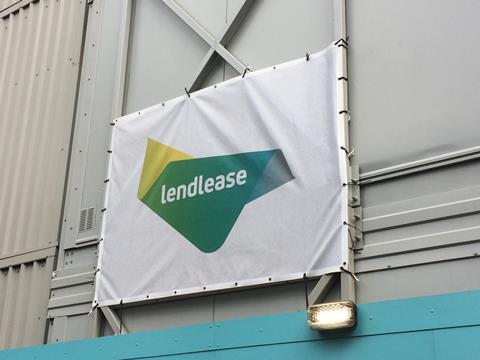
In March, Costain chief executive Andrew Wyllie retired after 14 years at the helm and was replaced by Alex Vaughan.
Another March movement was Nick Roberts, who joined Travis Perkins as chief executive from Atkins, where he was replaced by Phillip Hoare.
Former Crossrail boss Andrew Wolstenholme left BAE Systems in May after 12 months due to “personal reasons”.
Innovation
You could barely move in construction this year for modular and offsite innovations, with the government’s Innovate UK funding body investing up to £36m into collaborative research and development projects intended to transform the construction industry.
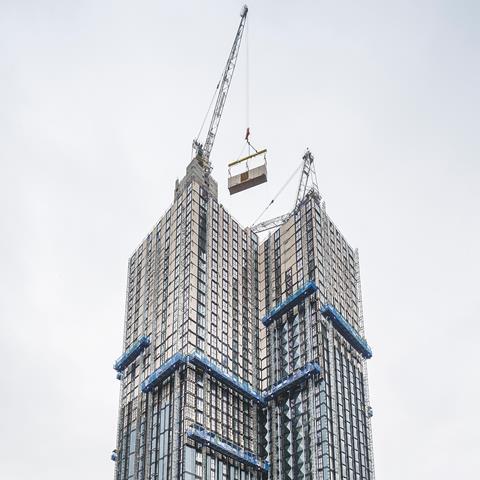
Modular projects in particular took centre stage, with the world’s tallest modular tower – 135m and constructed in Croydon, south London – nearing completion. It has since been usurped as the tallest by a 140m-high building in Singapore.
Virtual reality software is not new, but tech firms have been innovative in how VR is used to transform the way that developers, planners and contractors work.
Vu.City secured funding to collate intricate details of London’s buildings from Historic England and the Greater London Authority and to develop a tool to demonstrate how completed and in-construction buildings stand together. And Vinci, Skanska and BRE have collaborated on an AI tool that aims to utilise blockchain technology to fix construction’s productivity crisis.
In the summer a consortium of firms, backed by the Department for Education and led by consultant Blacc and including the Manufacturing Technology Centre and two offsite contractors, Elliott and the McAvoy Group, launched Seismic, a project that enables schools to be designed and built using offsite manufactured, standardised components in as little as two weeks.
Offsite boom:
>> March - MMC could spell end of main contractors on new school builds
>> July - DfE outlines offsite building boom
>> July - Offsite: Could schools soon be built in a fortnight?
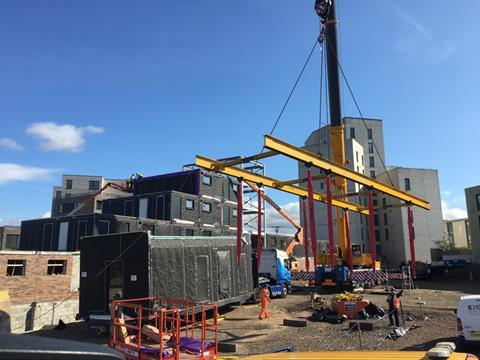
The government looked further afield, progressing talks with other governments to put British digital construction expertise to good use on projects around the world.
In October, the Centre for Digital Built Britain set up the digital twin hub to develop this technology, using real-time data to make better decisions on designing and constructing buildings as well as further societal benefits such as climate change.
–«ø’¥´√Ω safety
The end of 2018 was marked by the ban on combustible cladding materials on high-risk residential buildings over 18m taking effect. Rather than putting the flammable cladding issue to bed, the ban has intensified the debate over its merits.
>> Latest: Construction’s response to Grenfell
High-profile fires in low-rise residential buildings during 2019 have drawn attention to the arbitrary nature of the 18m height cut-off point. These included severe damage to a block of flats where the fire was spread via timber balconies, the destruction of a timber-framed care home where 150 residents were lucky to escape and a serious fire in an apartment block at Worcester Park in south-west London. Investigations revealed that cavity barriers, which prevent the spread of fire in cladding systems, were inadequate or missing at the block.

On the flip side many feel that the combustible cladding ban is too draconian, effectively sounding the death knell on the CLT industry and raising doubts over the use of PV and green walls on high-rise buildings.
>> –«ø’¥´√Ω Live Club debate: Cover to cover: Balancing facade safety with aesthetics
The implementation of Dame Judith Hackitt’s recommendations to improve building safety inched forwards with the launch of a government consultation in June. Proposals included placing new responsibilities for high-risk residential building safety onto designers, contractors and clients and a new building safety regulator to police them.
Experts warned that the complexities created by these proposals could cause projects to grind to a halt and the creation of a two-tier building control system with all the expertise centred on high-rise residential buildings. The government has not yet released the consultation responses, presumably preoccupied with Brexit.
The Hackitt review:
>> January - Hackitt frustrated by government’s slow response to report
>> June - Government launches consultation on Hackitt response
>> June - The Hackitt consultation: Calling for culture change
>> June - Hackitt explainer: What is the regulatory body?
>> June - Hackitt explainer: What are the three ‘gateways’?
>> October - Hackitt slams safety costs fears
The other Hackitt-related initiative was the launch of a report called Raising the Bar, which sets out a framework for the industry to improve the competence of 12 key specialisms. These range from architects and fire engineers to installers. An overarching body called the –«ø’¥´√Ω Safety Competence Committee will set standards for competence, issue guidance and drive improvement.
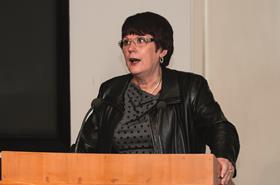
>> Explainer: Raising the Bar competence report
This should prove straightforward for specialisms with professional bodies such as the RIBA or RICS but is likely to be problematic for other installers. The cost and complexity of the proposa
















